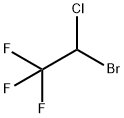≥99% , 151-67-7
Synonym(s):
2-Bromo-2-chloro-1,1,1-trifluoroethane;Halothane
CAS NO.:151-67-7
Empirical Formula: C2HBrClF3
Molecular Weight: 197.38
MDL number: MFCD00009602
EINECS: 205-796-5
| Pack Size | Price | Stock | Quantity |
| 125ML | RMB1096.55 | In Stock |
|
| 250ML | RMB1891.17 | In Stock |
|
| others | Enquire |
PRODUCT Properties
| Melting point: | -115.75°C |
| Boiling point: | 50.2 °C(lit.) |
| Density | 1.872 g/mL at 25 °C(lit.) |
| vapor pressure | 4.5 psi ( 20 °C) |
| refractive index | n |
| Flash point: | 49-50°C |
| storage temp. | 2-8°C |
| solubility | Slightly soluble in water, miscible with anhydrous ethanol and with trichloroethylene. |
| form | Colorless liquid |
| color | Colorless to light yellow |
| Water Solubility | Soluble in water (8 mg/ml). |
| Sensitive | Light Sensitive |
| Merck | 14,4603 |
| BRN | 1736947 |
| Exposure limits | TLV-TWA 50 ppm (~400 mg/m3) (ACGIH). |
| CAS DataBase Reference | 151-67-7(CAS DataBase Reference) |
| EPA Substance Registry System | Halothane (151-67-7) |
Description and Uses
Halothane was introduced into medical practice in the United States in 1956 as a
nonflammable, nonexplosive, halogenated volatile anesthetic that usually is mixed with air or
oxygen. The presence of the carbon–halogen bonds contributes to its nonflammability. This clear
liquid with a sweet odor was developed based on predictions that its halogenated structure would
provide chemical stability, an intermediate blood solubility, and significant anesthetic potency.
Halothane is the only useful volatile anesthetic possessing a bromine atom, which has been
suggested to contribute to its potency. Similarly, the addition of fluorine atoms, of which halothane
has three, is thought to contribute to the increased potency, volatility, and increased chemical
stability of the hydrocarbon skeleton.
Halothane produces rapid onset and recovery from anesthesia with high potency when used alone
or in combination with nitrous oxide. Most metals, with the exception of chromium, nickel, and
titanium, are easily tarnished by halothane. Although halothane is relatively stable, it is subject to
spontaneous oxidative decomposition to hydrochloric acid, hydrobromic acid, and phosgene. For
this reason, it is available in dark, amber glass containers with thymol added as a preservative to
minimize decomposition. Halothane may permeate into the rubber components of the anesthetic
delivery devices, which might account for some slowing of the induction onset and recovery.
Approximately 20% of an administered dose is metabolized, which accounts, in part, for the
increased hepatotoxicity observed with this agent.
depigmentor, antioxidant
Safety
| Symbol(GHS) |    GHS05,GHS07,GHS08 |
| Signal word | Danger |
| Hazard statements | H315-H318-H335-H360 |
| Precautionary statements | P201-P280-P305+P351+P338+P310-P308+P313 |
| Hazard Codes | T,Xi,Xn |
| Risk Statements | 61-37/38-41-40-20 |
| Safety Statements | 53-23-26-36/37-45-36 |
| RIDADR | UN 3334 |
| OEL | Ceiling: 2 ppm (16.2 mg/m3) [60-minute] [*Note: REL for exposure to waste anesthetic gas.] |
| WGK Germany | 3 |
| RTECS | KH6550000 |
| F | 8-19 |
| Hazard Note | Irritant |
| HS Code | 2937990000 |
| Hazardous Substances Data | 151-67-7(Hazardous Substances Data) |
| Toxicity | LD50 oral in rat: 5680mg/kg |





